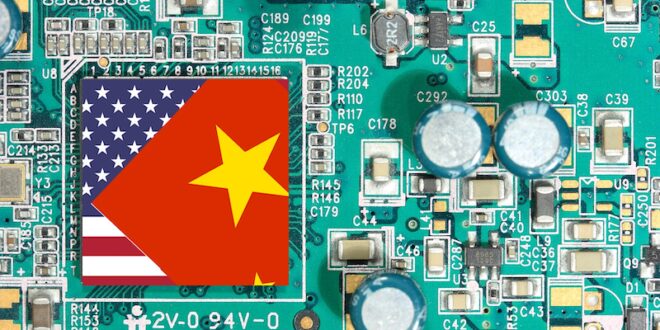The United States and China have entered a phase of competition for technological advantage, intensified by pandemic-induced supply chain vulnerabilities as well as a fundamental reorientation of global power dynamics where technology has come to play an unprecedented role.
According to Eric Schmidt, the former Google leader, “Many Americans still have an outdated vision of China… the United States now faces an economic and military competitor in China that is aggressively trying to close our lead in emerging technologies.”[1] Unless trends change significantly, the US will be competing with a China that is not only bigger in its economy but has better R&D, superior technologies, and stronger computing infrastructure. Decoupling, therefore, has become a necessary strategy for the US as China speeds up its tech advancements, many believe, by its use of unfair means. Such sentiments are supported by the bipartisan political consensus in Washington on the need to be tougher on China. However, decoupling bears costs and challenges for both the US and China. Areas like innovation, specialisation and costs are all expected to be impacted in both countries by the tech decoupling. One obvious area of impact is slowing global trade, changing the inherent characteristics of globalisation as we know it.
The core elements of technology and the competition around it have been underscored as a structural force that will shape the global competition, potentially resulting in new technological leaders or hegemonies in the next two decades.[2] For the US, China is at the heart of that concern.
Indeed, the US-China tech rivalry has become one of the most keenly observed areas in the emergent great-power discourse. Although the Biden administration’s recent export control measures[3] against China are the current reference point, the bilateral technology interface between the two countries has been a contested domain for some time now. As part of Trump’s trade war against China—including a plan to impose tariffs worth US$50 billion in May 2018—his administration imposed limits on Chinese investments in US high-tech industries.[4] It specifically targeted Chinese imports “containing industrially significant technology, including those related to the ‘Made in China 2025’ program”.[5] This step was part of a broader attempt by the US to protect its intellectual property rights and to curb Chinese acquisition of US technology through its growing investments in the sector. Expectedly, China threatened the US with retaliatory measures;[6] it has responded only selectively at the time of this writing.
At the heart of the emerging US tech concerns about China was the investigation[7] by the United States Trade Representative (USTR) in 2017 which found that China’s aggressive technology policies had put 44 million US jobs in the technology sector at risk in four ways: forced technology transfer; license requirements at less than economic value; China’s acquisition of industrially significant US technology for strategic purposes; and cyber theft. The US argued that these activities violated provisions of the United States Trade Act of 1974. Such transgressions prompted the US under Trump to file a violation dispute against China under WTO provisions in March 2018, laying the foundation for the tech-decoupling with China. Throughout the Trump presidency, tariff and export controls encouraged US companies to move their manufacturing bases out of China. President Trump banned ZTE, a Chinese telecoms-equipment maker, from buying American chips and denied Chinese company Huawei access to US components.
Biden Imprint
The Biden administration has doubled down on these measures, speeding the decoupling process. Perhaps the strongest impetus was provided by the Biden administration’s decision to implement the CHIPS Act 2022. Today, there is bipartisan consensus in the US Congress on enhancing technology controls, particularly in the so-called ‘strategic technologies’ where China’s rapid advancement is expected to challenge the US and threaten its national security and economic interests. The larger geopolitical challenge for the US is that China could use its techno-economic advantage for political leverage across the world and cause changes to the extant world order.
Given the primacy of technology in emerging geopolitics, the US focus on tech competition has both immediate and long-term motivations. The August 2022 Executive Order implementing the CHIPS Act of 2022 was critical in fundamentally altering the US’s relations with China. The Biden administration has not only sped up the process of tech decoupling with China but expanded it horizontally across sectors to make tech competition one of the primary fulcrums of US China policy.
Led by the Bureau of Industry and Security (BIS), the US imposed sanctions on the export of advanced semiconductors, chip-making equipment and supercomputer components to China. The US Entity List, which bars US firms from importing US goods without a license and contains names of individuals, companies, businesses and institutions that require a specific license for the “export, reexport and/or transfer (in-country) of specified items” has quadrupled, from 130 to 532, between 2018 and 2022.[8] As a result, most of the leading Chinese companies and organisations dealing with supercomputing, chip/semiconductor manufacturing are now present on the US Entity List, including China’s leading company Semiconductor Manufacturing International Corp. (SMIC), limiting China’s access to key US technologies. Chinese companies like Huawei have been particularly affected by the extension of BIS’s ‘foreign product direct rule’ to cover non-US items made using US technology.
The extension of US export controls has also affected the ability of third countries’ manufacturers and designers to sell chips to Chinese companies like Huawei. Effectively, these steps formed a decisive moment for three reasons: they stopped the supply of high-end semiconductor chips to China; halted China’s ability to get machines that manufacture chips globally; and stopped US citizens (including Green Card holders) from working for a Chinese semiconductor company or providing them support and knowhow.[9] The decision intended to provide incentives for research, development and manufacturing of semiconductors within the US.
The US under Biden is decoupling from China for two related reasons: to slow China’s technology-related advances, and in turn curb its economic and, more importantly, military ambitions. The long-raging debate between hawks and doves on China within the Biden administration seems to have ended with harsh and immediate steps being taken against China. More importantly, even harsher steps are now being anticipated from the Biden administration in other strategic sectors like biotech, manufacturing, and finance.[10] As chips are critical to Artificial Intelligence and technology, increasingly dependent sectors such as supply chains, e-commerce, autonomous vehicles, cybersecurity, medical imaging, drug discovery, climate modelling and defence production in China are expected to be hurt. However, even as these steps could slow Chinese economy and growth in multiple ways, it is also expected that US-led restrictions will trigger a domestic rush in chips manufacturing in China.
Fractured World Order
The US government’s decision to technologically decouple from China can be traced as far back as mid-2010. The latest sanctions are more ‘offensive’, however. With continuing measures such as export and import controls, inbound and outbound investment restrictions, licensing and visa bans and law enforcement, the US has also increased investments in technological research and development. The CHIPS Act appropriates US$52.7 billion over five years for semiconductor R&D, incentivises its manufacturing in the US, and lays out ambitious expansion plans for the National Science Foundation, Department of Energy, and National Institute of Standards and Technology. This is in line with proposals in the United States Innovation and Competition Act (USICA) and the COMPETES Act that seek to create strong foundational support for research especially in STEM sectors. The CHIPS Act also ushers other new provisions such as a 25-percent tax credit for investing in semiconductor manufacturing facilities in the US, limits expansion of semiconductor manufacturing in China, and authorises close to US$170 billion in funding over five years for research and development initiatives across multiple federal agencies.[11]
Although China has so far not reacted to Biden’s steps in the same way as it had to Trump’s in the 2018 tariff war, the sweeping regulations by the Biden administration has laid the foundation for further escalation in an already competitive duopoly between the two largest powers. At the global level, the steps taken by the US are also likely to redefine the metrics of great-power competition in the new world order that is hinged on technology and its use, even as chips have become central in both day-to-day living and in wars. The Russia-Ukraine war, for example, has underlined the centrality of chips in modern conventional wars. At the height of the war, Russia faced severe shortages in chips,[12] causing problems in the launch of missiles and other munitions. In what is a torturous cycle, wars like that in Europe, in turn, can have a debilitating impact on the production and supply of critical chips and affect the lives of citizens across the globe.[13]
The post-Ukraine world order has set the US and China on the path to tech decoupling, even as both countries have focused on domestic strengthening of tech manufacturing, greater economic control, and self-reliant agendas. While the US has focused on domestic growth, China has reinforced its vision through the ‘Made in China 2025’ (MIC 2025). It intends to boost competitiveness with the help of industrial rejuvenation and increasing its position in global manufacturing value chains, advancing rapidly in the emerging technologies sector, and reducing reliance on foreign firms. There are 10 sectors in China’s industrial priorities for 2015-2025: new-generation information technology; high-end computerised machines and robots; aerospace; maritime equipment and high-tech ships; advanced railway transportation equipment; new-energy and energy-saving vehicles; energy equipment; agricultural machines; new materials and biopharma and high-tech medical devices.[14] These innovation priorities have found technology, particularly chips, at the centre of their manufacturing and distribution processes. What the US is particularly concerned about is that China and its supported entities are being disingenuous in the acquisition and absorption of these technologies from the US and other countries and is recasting them as its own.[15] China denies these allegations.
Global Impact
The impact of US-China tech decoupling could rattle the world. Already, countries have started preparing cushions for the broader ramifications of these developments both by partnering with other countries and shoring up domestic manufacturing and supplies wherever possible. Despite the Semiconductor Industry Association’s advice for countries like the US and China to adopt a targeted regulation instead of sweeping bans to maintain a level playing field in the semiconductor industry, it remains shadowed by geopolitical interests of major powers.
Technology, particularly chip manufacturing, is central to modern economies and both the US and China have moved to ramp-up semiconductor manufacturing and control its supply in the future. Since 2020, at least 35 semiconductor companies across the US have pledged as much as US$200 billion in investments to boost domestic chips manufacturing. Leading among them are companies such as chip giant Intel which has recently pledged US$20 billion in two new factories in Ohio to make semiconductors; and Micron Technology which is expected to spend as much as US$20 billion by the end of this decade in the US. The Taiwan Semiconductor Manufacturing Company also plans to triple its investments in the US to US$40 billion.[16]
China is moving to close the tech gap with the US, committing as much as US$1.4 trillion over five years to build strategic technologies and digital infrastructure domestically. These include Artificial Intelligence, Chips, 5G, and Internet of Things. It is being anticipated that China will take the same US path in highly subsiding its domestic tech companies, a process which is already unraveling. In its endeavour to become technology self-sufficient, China is likely to focus more on ‘deep technology’ such as semiconductors and AI. In the process, huge state subsidies are likely to be provided by China to companies manufacturing chips and critical technologies. Already, a call for ushering tech breakthroughs by mobilising national resources has been given by Chinese leader Xi Jinping in September 2022.[17] At the 20th Party Congress shortly after, the Communist Party of China (CPC) declared technological innovation as the core driver of the country’s development.
The great decoupling between the US and China could manifest itself most conspicuously in four ways: technology, trade, finance, and people. In today’s geopolitical landscape between the two countries, all four are interlinked. The compulsions for decoupling with China, across a range of sectors led by technology, are provoked by the threats US faces in the national security domain from Beijing. Three critical documents brought out by the Biden administration—the National Security Strategy (NSS), National Defense Strategy (NDS), and Nuclear Posture Review (NPR)—all point to China as the most potent challenge to US hegemony, even as Russia’s war-led resurgence also presents a formidable threat. Most categorically, the US NSS defines China as the “only competitor with both the intent to reshape the international order and, increasingly, the economic, diplomatic, military, and technological power to advance that objective.” These assessments have placed the tech-threats from China to US among its core national security concerns, pushing the US to counter such threats by steps taken domestically as well as internationally.
Conclusion
While the tech-decoupling from China remains the Biden administration’s core concern, the US is expected to work with a larger network of countries to create a soft-landing impact on its own economy. US partnerships with like-minded partners and its allies are essential in tackling the China challenge and the wider ramifications of the regulations in the tech sector against China. As the US and China move towards dealing with the unraveling effects of tariff barriers, export controls, sanctions and blacklisting, two different trends are expected to emerge in China and the US-led coalition. The Chinese state will further press on with state support and subsidies to industries that deal with chips and other critical technologies, accelerating the process of attaining self-reliance in sensitive technologies and semiconductors. Bilaterally, China could retaliate by cancelling agreements on trade with the US including the recently signed Audit Firm Supervision Agreement, or by filing a complaint of violation against the US at the WTO.
Internationally, China could strengthen its partnerships and increase investments in countries that are rich in rare-earth materials, an important component of chips, while leveraging its own rare-earth deposits estimated at 44 million metric tonnes. On the US side, private enterprises are expected to act more freely in reducing the impact of the new restrictions and regulations by offshoring responsibilities to other countries and partners. Critical in such efforts will be the US-led ‘Chip 4’ alliance comprising Japan, South Korea and Taiwan—three countries which control much of semiconductor manufacturing, design and supplies. As Chinese threats to these three countries precede the chip-conundrum and are tied to the larger Pacific balance, they are only likely to intensify.
Lastly, the effort of the US to create a resilient technology partnership against China in the Indo-Pacific and beyond has to be carefully calibrated. Especially as the Biden administration enters a ‘democracy versus autocracy’ debate to target and differentiate from China, it has to be careful about the assessments from its other Indo-Pacific partners. Not all countries conform to Washington’s definition and understanding of democracy, especially those from the global South. The US should strike a balance and accommodate its other partners in the Indo-Pacific in its efforts to link a human rights ‘code of conduct’ with export controls.
With tech-related and tech-enhanced capabilities, ‘grey zone’ activities of countries are likely to increase. These expectations only heighten when assessed in relation to China. Only time will tell if US concern over China’s tech rise is overstated.
 Eurasia Press & News
Eurasia Press & News



